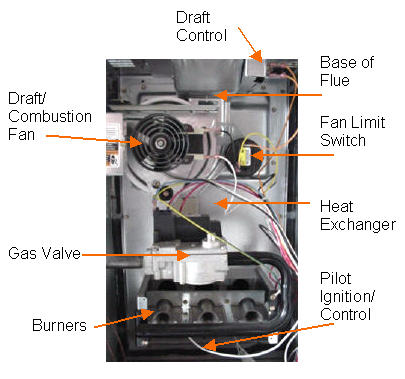However the blower or fan unit that delivers warm air to the living area will not turn on until the fan limit switch in the hot air supply plenum or furnace top senses that the air in that area is warm.
A residential gas furnace in operation.
Control board does a safety check limit switches roll out switches.
Carrier gas furnaces with greenspeed intelligence monitor temperature and humidity inside and out then automatically vary furnace operation as needed to provide an ideal combination of comfort and energy efficiency.
Flame sensor senses flame.
Finally the sequence of operation for the typical standing pilot gas furnace goes like this.
While most furnaces will follow the below sequences there may be variations in models and manufacturers.
An oil furnace generates heat using oil while gas furnaces are fueled by natural gas propane.
The flames heat up a metal heat exchanger and exhaust out of the flue.
The furnace is in standby mode waiting for a call for heat the thermostat has a call for heat which closes a switch inside the thermostat and sends 24 volts to the w heat terminal on the control board.
A call for heat from the thermostat.
But for the most part manufacturers have all gone to a hot surface or direct spark ignition the sequence of operation is as follows.
The white rodgers integrated furnace control i f c is an automatic ignition control module that uses microcomputer based circuitry to continuously monitor analyze and control the proper operation of the gas.
The thermostat reaches a set temperature and sends a signal for the furnace to turn on.
The gas side of the standing pilot gas furnace consists of a gas valve a pilot assembly the pilot and main burners and the flue which exhausts the gases after the combustion process is complete.
With greenspeed intelligence and variable speed components you can avoid wasting money for heating capacity you don t need.
The inducer motor begins to spin and creates a vacuum to insure the left over gasses go out the exhaust pipe.
The inducer draft combustion blower motor then starts.
Inducer motor comes on.
The lowest efficiency allowed by law for new gas furnaces is 78 percent and some new models achieve 97 percent.
A gas furnace made in the early 1970s typically has an afue of about 65 percent.
Gas furnace sequence of operation.
See furnace ecmtm2 motor operation.
Hot surface ignitor begins getting hot direct spark ignitor begins to spark.
Pressure switch must close to go to the next step.
A forced air furnace heats your home through a heating cycle that looks like this.
Variable speed furnace models using 50a51 505 506 507 controls.
Gas furnaces are typically more efficient and offer lower fuel costs but are more expensive than oil furnaces up front.
Oil furnaces are typically priced lower and provide more heat per btu but are less efficient.
Heat call from the thermostat.




















